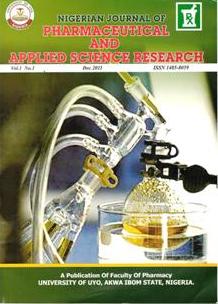Pharmacognostic Evaluation of leaf of Newbouldia laevis (P.Beauv.) Seem. Ex Bureau (BIGNONIACEAE)
Contenu principal de l'article
Résumé
consisting of the species commonly called boundary tree. It’s medicinal properties including antiulcer, antimicrobial, anticancer and antidiabetic activities. This study is aimed at evaluating pharmacognostic parameters which include: microscopy, micromeritics, chemomicroscopy, moisture content, ash values, extractive values,and fluorescence
Methods: Standard procedures were used to evaluate these Parameters
Results:The results obtained was that the leaf has hypostomatic distribution of stomata, that is stomata were found only on one surface of the leaf, the abaxial surface,which include anomocytic, anisocytic, and anomalous types of stomata, and glandular trichomes were present, then for the adaxial surface,stomata was absent, trichomes were also absent. stomatal index for abaxial surface was 27.31% and no values for the adaxial surface.The micromeritic evaluation of powdered drugs were, the bulk and tapped volumes, bulk and tapped densities were determined to be 44.66 ± 2.27, 30.05(mL) and 0.22 ± 0.01, 0.32 ± 0.004(g/mL) respectively. Subsequently, the Hausner ratio and Carr’s index were 1.47± 0.09 and 31.83 ± 4.46% respectively. From the experiment, Carr’s index and Hausner’s ratio of the leaf was greater than 25 % and 1.25 respectively and therefore indicates that the leaf powder has a poor flow property.The angle of repose was recorded to be 43.50o.The moisture content was 12.7% w/w.Chemomicroscopy identified mucilage, lignin, starch, oil,cellulose and protein, while fluorescence analysis revealed solvent-dependent color variations.
Conclusion: These findings support the identification and authentication of N. laevis, establishing standards for quality, purity, safety, and efficacy in Herbal medicine.
Téléchargements
Renseignements sur l'article

Cette œuvre est sous licence Creative Commons Attribution - Pas d'Utilisation Commerciale - Pas de Modification 4.0 International.
Références
Hassan SW, Salawu K, Ladan MJ, Hassan LG, Umar RA, Fatihu MY. Hepatoprotective, antioxidant and phytochemical properties of leaf extracts of Newbouldia laevis. International Journal of Pharmaceutical Technology Resources, 2010: 2(1): 573-84.
Kupchan SM, Monio JL, Sigel CW, Hemingway RJ. Tumor inhibitors. LXV. Bersenogenin, berscillogenin, and 3-epiberscillogenin, three new cytotoxic bufadienolides from Bersama abyssinica. Journal of Organic Chemistry, 1971: 36 (26): 11-16.
Schymanski EL, Jeon J, Gulde R, Fenner K, Ruff M, Singer H, Hollender J. Identifying Small Molecules Via High Resolution Mass Spectrometry: Communicating Confidence. American Chemical Society Publications, 2014: 2(4): 34 – 39.
Angiosperm Phylogeny Group. “An update of the Angiosperm Phylogeny Group classification for the orders and families of flowering plants: APG IV” Botanical Journal of the Linnean Society, 2016: 181(1): 1-20.
Johnny II, Umoh UF, Umoh RA, Alozie MF, Udobre AS, Igboasoiyi AC, Bassey ME, Andy NA, Udo IJ, Umoh OT. Pharmacognostic Characterization of Cola millenii K. Schum. (Malvaceae). Asian Journal of Biology, 2022: 14(1): 6-24.
Metcalfe CR, and Chalk L. Anatomy of the Dicotyledons. Clarendon Press, Oxford, 1979: 1(2):279.
African pharmacopoeia. General method of analysis of pharmacopoeia, 1986: 11: 121-208.
Mbah CC, Builders PF, Akuodor GC, Kunle OO. Pharmaceutical characterization of Bridelia ferniginea Benth. (Euphorbiaceae). Tropical journal of pharmaceutical research, 2012: 11(4):637-644
Kokate CK, Purohit AP, Gokhale SB. Pharmacognosy. Nairali Prakashan, 4th edition. 2003: 109 (119): 121 -123.
Kokoski CJ, Kokoski RJ, Slama FJ. Fluorescence of powdered vegetable drugs with particular reference tothe development of ultraviolet light radiation.Journal of the American Pharmaceutical Association, 1958: 38: 715- 719.
Kumar D, Gupta J, Kumar S, Arya R, Kumar T, Gupta, G. Pharmacognostic evaluation of Cayratia trifolia(Linn.) leaf. Asian Pacific Journal of Tropical Biomedicine. 2012: 2(1):6-10
Rahmatullah MD, Ferdausi MAH, Mollik R, Jahan MH, Chowdhury WM, Haque, A. Survey of Medicinal Plants used by Kavirajes of Chalna area, Khulna District, Bangladesh. African Journal of Traditional, Complementary and Alternative Medicines, 2010a: 7(2): 91-97.
Trease EC, Evans WC. Pharmacognosy. 16th Edition, W.B. Saunders, Philadelphia, 2009: 365-650.
Umoh RA, Umoh UF, Johnny II, Umoh OT, Anah VU, Udoh AE, Elijah AA, Adefabi M. A, Matthew EA. Phytopharmacognostic Evaluation of the Leaves of Gnetum africanumWelw (Gnetaceae). Journal of Complementary and Alternative Medical Research, 2022: 11(3):32-41.
Umoh RA, Johnny II, Udoh AE, Andy NA, Essien A, Udoh IJ, Ekpo TE, Ashibeshi GU. Taxonomic and Pharmacognostic Evaluation of Leaf of Mussaenda phillippica(Rubiaceae). Asian Plant Research Journal, 2022: 9(1): 6-13.
European Pharmacopoeia. Pharmacopoeial Limits of Crude Drugs. Strasbourg: Council of Europe, 2007: 6:124-164.


